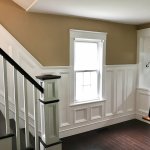I just finished up my first wainscoting project (not including some beaded board and panel cap) in my entry and up the stairs. My wife wanted a 2/3 wall height, but because of the stair ceiling I didn't think it would look right. So I matched it to an existing entry coat/shoe cubby and it ended up being 54". I understand that's a little untraditional, but the "client" is very pleased.
Now I need some advice – I've had three people ask for something similar in their house (since posting on FB yesterday). I'm 27 years in law enforcement, and am looking to learn a skill for retirement in threeish years. I'm not adverse to "apprenticing" and thinking I wouldn't mind doing small trim carpentry jobs. So here's the question,
What would you charge for something like this?
It's sixteen linear feet, 54" tall and made of MDF and pine baseboards. My cost, as best I can figure, is $15.56 per foot. I have no idea of my hourly rate, as I can't charge my jobby job rate...so I'm thinking 3-4 times the material cost?
If it makes a difference I'm in southeast PA – 19083.
Now I need some advice – I've had three people ask for something similar in their house (since posting on FB yesterday). I'm 27 years in law enforcement, and am looking to learn a skill for retirement in threeish years. I'm not adverse to "apprenticing" and thinking I wouldn't mind doing small trim carpentry jobs. So here's the question,
What would you charge for something like this?
It's sixteen linear feet, 54" tall and made of MDF and pine baseboards. My cost, as best I can figure, is $15.56 per foot. I have no idea of my hourly rate, as I can't charge my jobby job rate...so I'm thinking 3-4 times the material cost?
If it makes a difference I'm in southeast PA – 19083.



